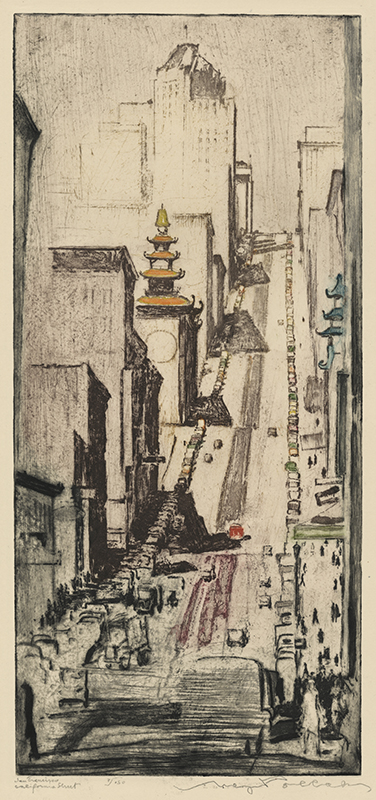San Francisco California Street is a drypoint and color aquatint, colored a la poupée created about 1940 by Austrian-born, American artist Max Pollak. It is pencil signed, titled and editioned 4/150. San Francisco California Street was printed on an ivory wove paper and the platemark measures 17-1/2 x 8 inches. This title is listed as number 79 on the checklist for Pollak’s exhibition at the University of California in the Spring of 1949.
California Street has four to six lanes for its entire length. A cable car line runs on the eastern portion from Market Street to Van Ness Avenue and a trolleybus line runs on the western portion between Steiner and 32nd Avenue. California Street begins at the intersection of Market Street, Main Street, and Drumm Street, one block from the Ferry Building. The street travels through Chinatown, Nob Hill, Lower Pacific Heights, Laurel Heights, and the Lake District. In San Francisco California Street, Pollak features the ascent through Chinatown with its distinctive pagoda of the Sing Fat Company building toward Nob Hill with intersecting streets creating horizontal breaks. Pollak used figures and lines of parked cars to give a sense of depth and perspective.
Max Pollak, painter and printmaker, was born in Prague, Czechoslovakia in 1886. He was raised in Vienna and, in 1902, he entered the Vienna Academy of Art where he studied under William Unger and Ferdinand Schmutzer. In 1912, Pollak traveled to Italy, France, and Holland to study and paint. During the First World War, he was appointed painter of the Austrian Army.
He immigrated to the United States in 1927, living for a time on the east coast where he produced a series of color aquatints of New York, Cincinnati, and Detroit. His first exhibition was at the 57th Street Art Gallery in New York and he was commissioned by Theodore Dreiser in 1929 to illustrate his book, My City. In 1938, Pollak and his wife, Friedl, moved to San Francisco, California. Pollak was inspired by his new city and its environs and produced beautiful views of San Francisco Bay Area. Later travels included trips to Mexico and Guatemala.
Max Pollak was a member of the Chicago Society of Etchers and the California Society of Etchers. His work is represented in the collections of the Magnes Collection of Jewish Art and Life, Berkeley, California; the Jordan Schnitzer Museum of Art, University of Oregon, Eugene; the British Museum, London; the Metropolitan Museum of Art and the New York Public Library, New York; the Oakland Museum of California Art; the Fine Arts Museums of San Francisco, California; and the Smithsonian American Art Museum, Washington, D.C.



